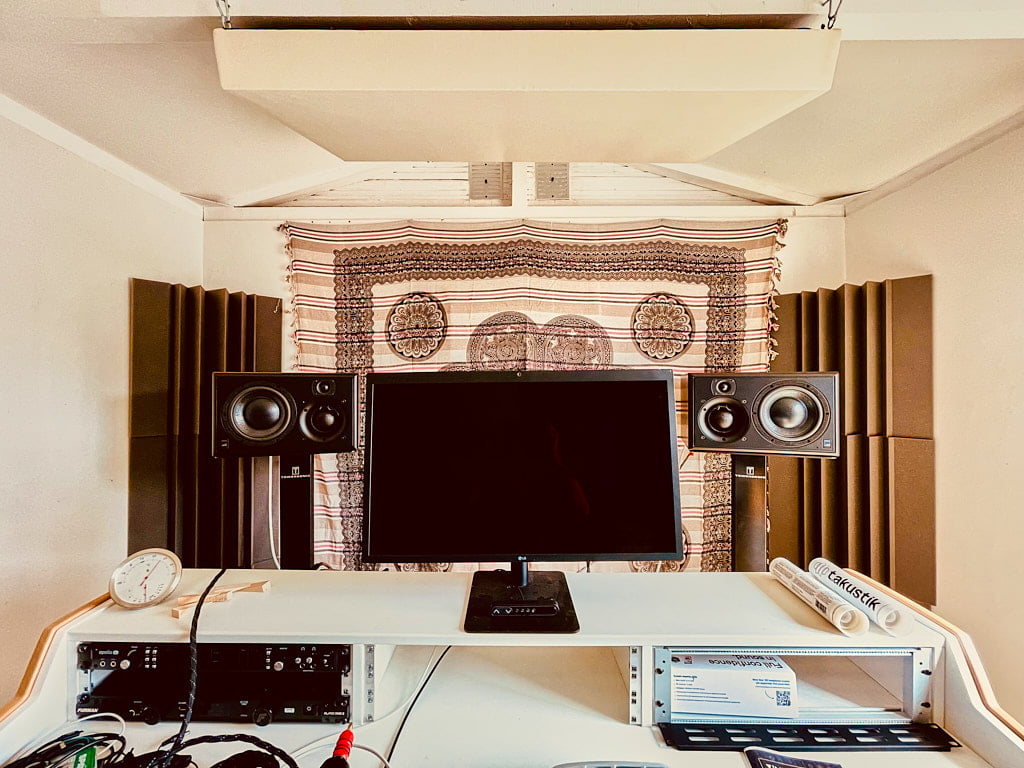Acoustic room treatment
The four red elements on the wall are diffusers. In the background, you can see a grey absorber and a bass-trap in the corner.
A short introduction to Acoustic room treatment
Acoustic room treatment is a critical aspect of creating a professional recording studio. A well-treated room can make a significant difference in the quality of recordings and help to reduce unwanted noise and sound reflections. Here are some of the reasons why acoustic room treatment is necessary:
- Improved Sound Quality: Acoustic treatment helps to absorb unwanted reflections and standing waves that can negatively impact the sound quality of recordings. By reducing these reflections, recordings will have a clearer and more focused sound, making it easier to achieve a professional-quality mix.
- Enhanced Accuracy: A treated room helps to eliminate coloration and distortion in the sound, providing a more accurate representation of the sound source. This is particularly important for recording studios, where the goal is to capture the true sound of the instruments and vocals.
- Improved Isolation: Acoustic treatment can also help to reduce the amount of sound that leaks into or out of the recording studio. This is important for preventing bleed and noise from interfering with recordings and for maintaining the privacy of the recording session.
- Increased Comfort: A treated room can also make the recording experience more comfortable for the musicians and engineers. By reducing unwanted noise and reflections, the room will be more acoustically comfortable, which can lead to better performances and less fatigue for those involved in the recording process.
The mixing/mastering area of the ASV Studio during installation. Above the desk is an absorber, behind the speakers some basstraps..
Basic elements used in acoustic room treatment
- Absorption panels: Soft materials like acoustic foam, fiberglass, or rock wool that reduce sound reflections and echo.
- Bass traps: Large, thick panels that target low-frequency sound waves and reduce bass build-up in corners.
- Diffusers: Panels or shapes that scatter sound evenly to reduce echo and improve clarity.
- Soundproofing materials: Heavy materials like mass-loaded vinyl or soundproofing mats that block sound from entering or leaving a room.
- Reflectors: Hard, flat surfaces that can be angled to control the direction of sound reflections.
- Acoustic curtains: Heavy curtains that can be used to cover windows or doorways to reduce outside noise.
These elements are used together in a specific configuration to address specific acoustic problems in a room and improve its overall sound quality.
In conclusion, acoustic room treatment is essential for creating a professional recording studio. By reducing unwanted reflections and noise, enhancing accuracy, improving isolation, and increasing comfort, acoustic treatment can significantly improve the quality of recordings and make the recording process more enjoyable and productive.
Advise needed?
You want to treat your room to sound beter, build your own studio or enhance a rehearsal space for your band? Send me a note, I can help you during this process.


